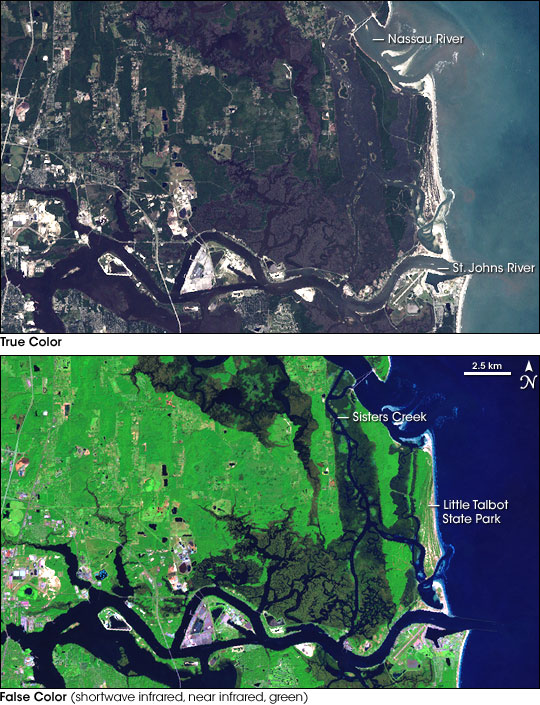


In northeastern Florida, just north of fast-growing Jacksonville, the Nassau, the St. Marys, and the St. Johns Rivers flow lazily toward the Atlantic Ocean through a broad maze of islands, canals, and tidal marshes. Hammocks of land rise above the floodplain, supporting forests that are home to rare plants and animals, such as the Florida black bear and the red-cockaded woodpecker. The coastal estuaries and barrier islands are habitat for manatees, right whales, and sea turtles. Recently, the Nature Conservancy added about 10,000 acres of tidal marshes to the area’s protected lands. The new preserve is called Machaba Balu, which in the language of the Timucuan Indians, some of the area’s early residents, means ”saved marsh.”
These images show the area between the Nassau River (north) and the St. Johns River (south) just north of Jacksonville. The Atlantic Ocean is at image right. In the photo-like image (top), rivers and streams appear purplish blue, natural vegetation appears deep green, and bare surfaces, including beaches, developed areas, and roads, appear bright white or gray. In the infrared-enhanced image (bottom), water appears blue, vegetation appears bright green, and bare or thinly vegetated ground appears pinkish. This false-color image makes the flooded saltwater marshes stand out better from forests and other vegetation. The Machaba Balu Preserve includes numerous individual tracts of marsh between the Nassau and the St. Johns Rivers. The largest clusters are concentrated just to the west of Little Talbot State Park and on either side of Sisters Creek south of the large fork. The images are made from data collected by the Enhanced Thematic Mapper Plus sensor on the Landsat satellite on October 23, 1999.
Coastal estuaries and tidal marshes are the interface between land and ocean. All over the world they provide critical habitat for plants and animals, including many that humans depend on for food. They provide flood control and storm-surge protection, and they filter out pollutants that would otherwise flow unchecked from land to ocean.
Recognizing the tremendous importance of oceans and coastal areas to the nation’s heritage, economy, and security, President Bush proclaimed the week of June 4-10, 2006, to be National Oceans Week and reaffirmed the country’s commitment to protecting marine resources “through wise stewardship and sensible management.” Preserves such as Machaba Balu are an important part of strategies that will preserve coastal resources in the midst of Jacksonville’s rapid growth.
NASA images created by Jesse Allen, Earth Observatory, using data obtained from the University of Maryland’s Global Land Cover Facility.